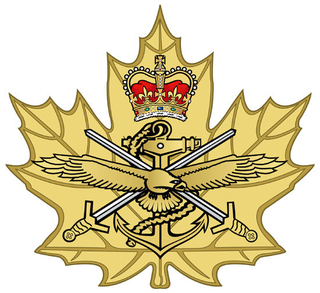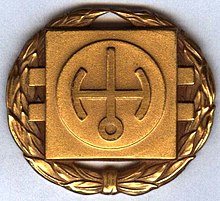
The Submarine Warfare Insignia are worn by qualified submariners.

The Cadet Instructors Cadre (CIC) Branch consists of approximately 7,500 Canadian Forces (CF) officers whose primary duty is the safety, supervision, administration and training of Royal Canadian Sea, Army, and Air Cadets. The Branch is the largest single group within the Canadian Forces reserve force subcomponent Cadet Organizations Administration and Training Service (COATS) and is the largest officer branch in the Canadian Forces. The COATS subcomponent of the Reserve Force employs members from all branches and occupations of the Royal Canadian Navy, Canadian Army, and Royal Canadian Air Force of the Canadian Forces.

The Driver and Mechanic Badge is a military special skill badge of the United States Army which was first created in July 1942. The badge is awarded to drivers, mechanics, and special equipment operators to denote the attainment of a high degree of skill in the operation and maintenance of motor vehicles. The badge was originally referred to as the “Motor Vehicle Badge” and adopted its current title of Driver and Mechanic Badge during the Korean War.

The diver insignia are qualification badges of the uniformed services of the United States which are awarded to servicemen qualified as divers. Originally, the diver insignia was a cloth patch decoration worn by United States Navy divers in the upper-portion of the enlisted service uniform's left sleeve during the first part of World War II, when the rating insignia was worn on the right sleeve. When enlisted rating insignia were shifted to the left sleeve in late World War II, the patch shifted to the upper right sleeve. The diving patch was created during World War II, and became a breast insignia in the late 1960s.
The Missile Badge is a military decoration of the United States Air Force which was first created on 23 May 1958. The "pocket rocket" badge recognizes those commissioned officers and enlisted personnel of the US Air Force who have qualified as missile personnel that have been trained in the maintenance or launching of land-based and air-launched nuclear weapons under the direction of the National Command Authority. Originally known as the Missileman Badge, the Missile Badge later became known as the Missileer Badge or more informally the Pocket Rocket and is still often referred to by this name.

Insignias and badges of the United States Navy are military "badges" issued by the United States Department of the Navy to naval service members who achieve certain qualifications and accomplishments while serving on both active and reserve duty in the United States Navy. Most naval aviation insignia are also permitted for wear on uniforms of the United States Marine Corps.

Insignia and badges of the United States Marine Corps are military "badges" issued by the United States Department of the Navy to Marines who achieve certain qualifications and accomplishments while serving on both active and reserve duty in the United States Marine Corps.

River Bend Nuclear Generating Station is a nuclear power station on a 3,300-acre (1,300 ha) site near St. Francisville, Louisiana in West Feliciana Parish, approximately 30 miles (50 km) north of Baton Rouge. The station has one sixth generation General Electric boiling water reactor that has a nominal gross electric output of about 1010 MWe. Commercial operation began on June 16, 1986.
The Aircrew Badge, commonly known as Wings, is a qualification badge of the United States military that is awarded by all five branches of armed services to personnel who serve as aircrew members on board military aircraft. The badge is intended to recognize the training and qualifications required by aircrew of military aircraft. In order to qualify as an aircrew member and receive the Aircrew Badge, such personnel typically undergo advanced training in aircraft in-flight support roles.
SM-1 was a 2-megawatt nuclear reactor developed by the United States Atomic Energy Commission for the US Army Nuclear Power Program (ANPP) in the mid-1950s. The compact "package" reactor was designed to produce electricity and generate heat for remote military facilities. The first, the SM-1, served as the Army's primary training facility to train reactor operations personnel from all three services. In 1954, the Department of Defense placed the US Army in charge of all military nuclear power plants except those used for propulsion by the US Navy. The Army's Chief of Engineers established the US Army Engineer Reactors Group in April 1954, and decided to construct the SM-1 facility at the Corps of Engineers headquarters at Fort Belvoir, Virginia, about 18 miles south of Washington, D.C.. About 800 personnel were trained on the SM-1 during its operational life, from 1957 to 1973. The power plant was shut down in March 1973, and is monitored within a "restricted access" section of the post. Inspectors enter the shut-down operations control room every decade or so. The Army plans to start demolition in 2020.

Machinist's mate is a rating in the United States Navy's engineering community.
A reactor operator is an individual at a nuclear power plant who is responsible for directly controlling a nuclear reactor from a control panel and is the only individual at a nuclear power plant who can directly alter significant amounts of reactor reactivity. The reactor operator occupies a position of great responsibility that may require him or her to start up a nuclear reactor, shut down a critical nuclear reactor, monitor reactor parameters, or respond to a casualty of the nuclear reactor.

The Swiss Federal Nuclear Safety Inspectorate is Switzerland's regulatory supervisory authority for nuclear safety and for the security of nuclear installations; it supervises the nuclear power plants at Beznau, Gösgen, Leibstadt and Mühleberg, the research reactors at the Paul Scherrer Institute, the University of Basel and the Swiss Federal Institute of Technology, as well as the Swiss national central interim storage facility for radioactive waste (ZWILAG). ENSI's headquarters are located in Brugg in the Canton of Aargau.

The Zwentendorf Nuclear Power Plant was the first commercial nuclear plant for electric power generation built in Austria, of 3 nuclear plants originally envisioned. Construction of the plant at Zwentendorf, Austria was finished but the plant never entered service. The start-up of the Zwentendorf plant, as well as the construction of the other 2 plants, was prevented by a referendum on 5 November 1978. A narrow majority of 50.47% voted against the start-up.

Nuclear Power School is a technical school operated by the U.S. Navy in Goose Creek, South Carolina to train enlisted sailors, officers, KAPL civilians and Bettis civilians for shipboard nuclear power plant operation and maintenance of surface ships and submarines in the U.S. nuclear navy. The United States Navy currently operates 95 total nuclear power plants including 71 submarines, 10 aircraft carriers, and 4 training/research prototype plants.
The United States Navy job rating of Electronics Technician is a designation given by the Bureau of Naval Personnel (BUPERS) to enlisted members who satisfactorily complete initial Electronics Technician "A" school training.

Army Engineer Divers are members of national armies who are trained to undertake reconnaissance, demolition, and salvage tasks underwater. These divers have similar skills and qualifications as professional divers. In the United States Army they are members of the Corps of Engineers. In the British Army they may be Royal Engineers Divers or Commando Engineer Divers.


















